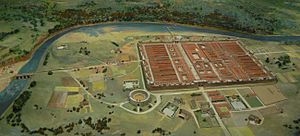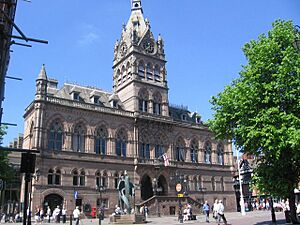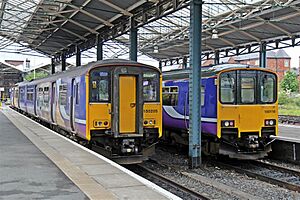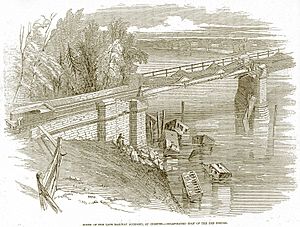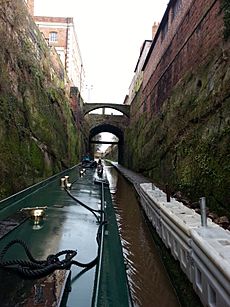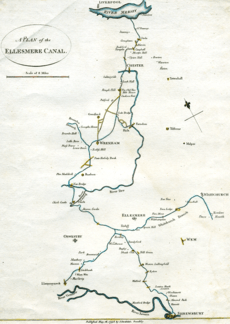Chester facts for kids
Quick facts for kids Chester |
|
|---|---|
| City | |
|
Clockwise from top: Eastgate Street, the town hall, castle, Roman amphitheatre and cathedral |
|
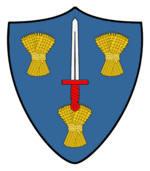 Coat of arms |
|
| Population | 92,760 (Built up area, 2021) 138,875 (Official city, 2021) |
| Demonym | Cestrian |
| OS grid reference | SJ405665 |
| • London | 165 mi (266 km) SE |
| Unitary authority |
|
| Ceremonial county | |
| Region | |
| Country | England |
| Sovereign state | United Kingdom |
| Post town | CHESTER |
| Postcode district | CH1–4 |
| Dialling code | 01244 |
| Police | Cheshire |
| Fire | Cheshire |
| Ambulance | North West |
| EU Parliament | North West England |
| UK Parliament |
|
Chester is a historic city in Cheshire, England. It sits right by the River Dee and is very close to the border with Wales. In 2021, about 92,760 people lived in its main built-up area. Chester is known as the county town of Cheshire.
The city was started by the Romans in 79 AD. They built a fort called Deva Victrix. This fort was one of the most important army camps in Roman Britain. Later, a large town grew around it. In 689, King Æthelred of Mercia founded a church that became Chester's first cathedral. The Angles also made the city walls stronger to protect against invaders. Chester was one of the last English cities to be taken by the Normans. William the Conqueror then built a castle there. Chester officially became a city in 1541.
Chester's city walls are some of the best-preserved in the UK. They are almost complete, except for a small part. The city also has many old buildings. However, many of the famous black-and-white buildings you see today were rebuilt in the Victorian era. This was part of a style called the Black-and-white Revival. The Industrial Revolution brought railways and canals, helping Chester grow a lot. Today, tourism, shopping, and financial services are very important to the city's economy. Chester even calls itself Chester International Heritage City on road signs.
Contents
Chester's Story Through Time
Roman Beginnings
The city of Chester was founded by the Romans in 79 AD. It was built as a fort called Deva Victrix. This happened during the time of Emperor Vespasian. The fort was set up in the land of the Celtic Cornovii people. Its name, Deva, likely came from the goddess of the River Dee. The "Victrix" part came from the Roman army group, the Legio XX Valeria Victrix, stationed there.
The four main roads in central Chester today (Eastgate, Northgate, Watergate, and Bridgegate) still follow the paths the Romans first laid out. A town grew up around the fort as people traded with the soldiers. This fort was much bigger than other Roman forts in Britain at the time. Some historians think it might have been planned to be the capital of Roman Britain, not London!
The Roman amphitheatre was built in the 1st century. It could hold 8,000 to 10,000 people. This makes it the largest known military amphitheatre in Britain. It is also a protected historical site. The Minerva Shrine is a unique Roman shrine carved into rock. It is the only one still in its original place in Britain.
The Roman army stayed in the fort until at least the late 4th century. By 410 AD, the Romans left Britain. But the local people, who had adopted Roman ways, stayed. They probably kept using the fort's walls for protection.
Medieval Times
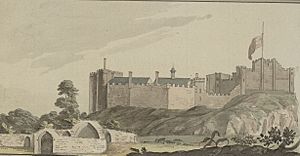
After the Romans left, Chester became part of a small kingdom called Powys. The Welsh name for Chester was Deverdoeu. Another old name was Cair Legion, meaning "Fort of the Legion". This later became Caerlleon in Welsh.
In 616, a battle took place at Chester. The Anglo-Saxons won, which helped them gain control of the area. The Anglo-Saxons called the city Legacæstir. This name was used until the 11th century when it became simply Chester.
In 689, King Æthelred of Mercia founded the Minster Church of West Mercia. This church later became St John's Church. It was Chester's first cathedral. The body of St Werburgh was moved to Chester in the 9th century. This was to protect it from Danish raiders. Her name is still remembered in St Werburgh's Street today.
The Anglo-Saxons made Chester's walls stronger to defend against the Danes. Later, in 973, King Edgar of England came to Chester. He held his court there and was rowed up the River Dee by six kings.
In 1071, William the Conqueror made Hugh d'Avranches the first Earl of Chester. Hugh built Chester Castle. From the 1300s to the 1700s, Chester was often called Westchester. This was because of its important location in North West England.
Modern Chester
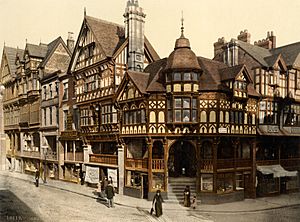
Chester played a big part in the Industrial Revolution. This period of major change began in the late 1700s. Areas like Newtown and Hoole became busy industrial centers. They had large markets, canals, and railway stations. These areas provided many workers and helped create much of Chester's wealth. By 1841, the city's population had grown to over 23,000 people.
A lot of land in Chester is owned by the Duke of Westminster. His family name, Grosvenor, is used for many places in the city. Examples include the Grosvenor Bridge and the Grosvenor Hotel. Many of Chester's Victorian buildings were designed by John Douglas. He was the Duke's main architect. He often used twisted chimney stacks in his designs.
After World War II, Chester needed more affordable homes. So, new housing areas like Blacon were built in the 1950s and 1960s. In 1964, a bypass road was built to help with traffic. People worried these changes would harm the city's historic feel. In 1968, a report suggested protecting old buildings. This led to many historic buildings being saved and used in new ways.
In 2002, Chester became the first UK Fairtrade City. This means it supports fair trade practices.
How Chester is Run
Chester is governed by the Cheshire West and Chester Council. This council handles local services for the city and surrounding areas. Some parts of Chester are separate parishes, like Great Boughton. But most of the city centre is not.
The city has its own Member of Parliament (MP). This person represents Chester in the UK Parliament.
City Status and History
Chester has been an important town for a long time. It received its first official papers, called charters, in the 1100s. In 1506, it gained the right to choose its own sheriffs. This made it a special area, separate from the rest of Cheshire. Chester became a city in 1541 when the Diocese of Chester was created.
In 1889, Chester became a "county borough." This meant it was big enough to manage its own county-level services. It was independent from Cheshire County Council. In 1974, the county borough was ended. Chester then became part of a larger district. The city status was extended to cover this whole new district. In 1992, Chester was given the right to appoint a Lord Mayor.
In 2009, local government in Cheshire changed again. Chester City Council was removed. A new council, Cheshire West and Chester, was formed. But Chester's city status is still kept alive by special groups called charter trustees. They also appoint the Lord Mayor. The official city area, including some rural parts, had a population of 138,875 in 2021.
Chester's Location and Weather
Chester is built on a Triassic sandstone ridge. This ridge is about 42 meters high. The city is located in a natural S-bend of the River Dee. The rocks here, called Chester Pebble Beds, have many small stones in them. Ice from ancient glaciers also left behind sand and clay.
The eastern and northern parts of Chester used to be open land and forests. The western side, near the Dee Estuary, was marshy and wet.
Climate
Chester has a mild climate, typical for the British Isles. It's called an oceanic climate. Even though it's near the Irish Sea, its temperatures are similar to places further inland. This is because nearby mountains protect it from strong winds.
The hottest temperature ever recorded was 37.1°C on July 18, 2022. On average, the warmest day each year reaches about 29.3°C. The coldest temperature recorded was -18.2°C in January 1982. On average, there are about 42 frosty days each year.
Chester gets about 700mm of rain annually. This is not a lot, thanks to a "rain shadow" effect from the Welsh Mountains. It rains more than 1mm on about 135 days a year.
| Month | Jan | Feb | Mar | Apr | May | Jun | Jul | Aug | Sep | Oct | Nov | Dec | Year |
|---|---|---|---|---|---|---|---|---|---|---|---|---|---|
| Record high °C (°F) | 16.1 (61.0) |
17.2 (63.0) |
22.2 (72.0) |
25.8 (78.4) |
28.3 (82.9) |
32.2 (90.0) |
33.1 (91.6) |
35.2 (95.4) |
32.3 (90.1) |
28.2 (82.8) |
19.6 (67.3) |
16.7 (62.1) |
35.2 (95.4) |
| Mean daily maximum °C (°F) | 8.1 (46.6) |
8.8 (47.8) |
10.9 (51.6) |
13.6 (56.5) |
16.7 (62.1) |
19.3 (66.7) |
21.1 (70.0) |
20.7 (69.3) |
18.4 (65.1) |
14.6 (58.3) |
10.9 (51.6) |
8.4 (47.1) |
14.3 (57.7) |
| Daily mean °C (°F) | 4.9 (40.8) |
5.4 (41.7) |
7.0 (44.6) |
9.1 (48.4) |
12.0 (53.6) |
14.8 (58.6) |
16.6 (61.9) |
16.3 (61.3) |
14.1 (57.4) |
10.9 (51.6) |
7.6 (45.7) |
5.2 (41.4) |
10.3 (50.5) |
| Mean daily minimum °C (°F) | 1.8 (35.2) |
2.0 (35.6) |
3.0 (37.4) |
4.5 (40.1) |
7.2 (45.0) |
10.3 (50.5) |
12.1 (53.8) |
12.0 (53.6) |
9.8 (49.6) |
7.2 (45.0) |
4.3 (39.7) |
2.1 (35.8) |
6.4 (43.5) |
| Record low °C (°F) | −18.2 (−0.8) |
−17.8 (0.0) |
−12.4 (9.7) |
−3.9 (25.0) |
−1.6 (29.1) |
−0.3 (31.5) |
3.5 (38.3) |
2.2 (36.0) |
−0.1 (31.8) |
−7.2 (19.0) |
−9.9 (14.2) |
−17.2 (1.0) |
−18.2 (−0.8) |
| Average rainfall mm (inches) | 59.9 (2.36) |
49.5 (1.95) |
48.2 (1.90) |
49.5 (1.95) |
52.9 (2.08) |
64.5 (2.54) |
60.0 (2.36) |
58.9 (2.32) |
62.2 (2.45) |
76.2 (3.00) |
71.3 (2.81) |
75.6 (2.98) |
728.8 (28.69) |
| Average rainy days | 13.0 | 10.8 | 11.0 | 10.2 | 9.2 | 10.0 | 10.0 | 10.5 | 10.3 | 12.7 | 14.7 | 14.2 | 136.7 |
| Mean monthly sunshine hours | 63.9 | 81.6 | 122.5 | 177.6 | 209.1 | 190.9 | 199.0 | 171.2 | 142.1 | 90.6 | 67.9 | 56.1 | 1,572.5 |
| Source 1: Met Office Monthly Weather Report | |||||||||||||
| Source 2: Meteo Climat CEDA Archive | |||||||||||||
Areas and Neighbourhoods
The Chester Urban Area includes the city of Chester and its surrounding neighbourhoods. This area also includes the town of Saltney in North Wales. Other parts are Bache, Blacon, Boughton, Curzon Park, Great Boughton, Handbridge, Huntington, Hoole, Kingsway, Lache, Moston, Newton, Newtown, Queens Park, Upton, Vicars Cross and Westminster Park.
Some villages just outside the city are Christleton, Eccleston, Guilden Sutton, Littleton, Mickle Trafford, Mollington, Saughall and Waverton.
Famous Places and Fun Things to Do
Chester has many unique landmarks. These include the city walls, the Rows, and its black-and-white buildings. The city walls go all around the old medieval city. They are almost 2 miles long and are the most complete city walls in Britain. You can walk along the top of the walls. They cross roads with bridges and pass by old towers like Phoenix Tower. On Eastgate, you'll see the Eastgate Clock. People say it's the most photographed clock face in England after Big Ben.
The Rows are special to Chester. They are buildings with shops on two levels. The ground floor shops are often lower than the street. The first-floor shops are set back, with a continuous walkway in front. Many of Chester's central buildings look medieval. But most of them, especially the black-and-white ones, were built in the Victorian era. Architects like John Douglas and T.M. Lockwood led this "black-and-white revival."
The most important buildings in the city centre are the town hall and the cathedral. The town hall opened in 1869. It is built in a Gothic Revival style with a tower. The cathedral used to be a church for an abbey. It has parts from the Norman period and was restored in the 1800s. Its choir stalls have beautiful carvings. The shrine of St Werburgh is also in the cathedral.
The oldest church in the city is St John's. It's outside the city walls and was once the cathedral. At the meeting point of the old Roman roads is Chester Cross. Nearby is St Peter's Church, which is now a community centre. Other old churches have been given new uses, like a heritage centre or guildhall. The shot tower is the tallest building in Chester.
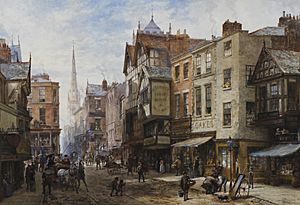
You can still find Roman remains in Chester. Some are in building basements or in the lower parts of the city walls. The most important Roman site is the amphitheatre outside the walls. Roman items are also shown in the Roman Gardens. Here, you can see a reconstructed Roman heating system called a hypocaust. An original hypocaust can be seen in the basement of 39 Bridge Street.
The medieval Chester Castle is another important old structure. Much of it has been rebuilt in a newer style. South of the city is the River Dee, with its 11th-century weir. The river is crossed by the Old Dee Bridge (from the 1200s) and the Grosvenor Bridge (from 1832). The area by the river is called the Roodee. It has Chester Racecourse, where horse races and other events are held. The Shropshire Union Canal runs north of the city.
The main museum in Chester is the Grosvenor Museum. It has Roman tombstones and an art gallery. The Deva Roman Experience offers interactive exhibits and a recreated Roman street. The Cheshire Military Museum is in the castle area.

Grosvenor Park is Chester's main public park. On the south side of the River Dee, you'll find Edgar's Field. This park has Minerva's Shrine, a Roman shrine. A war memorial for those who died in the world wars is in the town hall.
You can take boat trips on the River Dee and the Shropshire Union Canal. There are also open-top bus tours. These tours start from an area by the river called the Groves. Chester hosts several festivals, including music and literature events. There's a Tourist Information Centre at the town hall.
Education in Chester
Chester is home to the University of Chester. It used to be a college for training teachers. It became a full university in 2005. It is the main place for higher education in the county. The University of Law also has a campus nearby.
Cheshire College – South & West is a college that teaches practical skills. It has campuses in Handbridge and other towns.
There are also several secondary schools:
- The King's School (a private school for boys, founded in 1541)
- Queen's School (a private school for girls, founded in 1878)
- Bishops' Blue Coat C of E
- Catholic High School
- Queens Park High School
- Upton-by-Chester High School
- Blacon High School
- Christleton High School
Culture and Arts
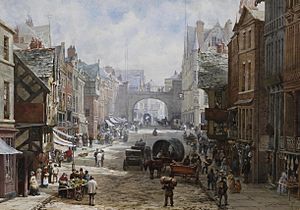
The main museum is the Grosvenor Museum. It has Roman artifacts and an art gallery. The Dewa Roman Experience offers interactive displays about Roman life. The Cheshire Military Museum is located at Chester Castle.
The £37 million Storyhouse arts centre opened in 2017. It has a theatre, a cinema, a restaurant, and the city's main library. It is built in a remodelled old cinema.
Chester Little Theatre and Chester Music Theatre put on plays and musicals. There are also many pubs, nightclubs, and bars, some in very old buildings.
Music Scene
Chester has a professional classical music festival. A new music festival, Chester Music Festival, started in 2013. It features a professional music group called Ensemble Deva.
The composer Howard Skempton was born in Chester in 1947. Chester has a brass band, The City of Chester Band, which started in 1853. The Chester Music Society has a choir and youth choirs. The Chester Philharmonic Orchestra (CPO) was founded in 1884. It performs concerts, often in Chester Cathedral.
Telford's Warehouse and Alexander's Jazz Bar are popular live music venues. Chester Rocks is an annual music festival held at the racecourse.
Some famous musicians from Chester include the founding members of River City People and the band Mansun.
Media
Chester has local newspapers like the Chester Chronicle and Chester Standard.
Chester's Dee Radio is the city's radio station. You can also listen to other regional stations. The TV show Hollyoaks is set in Chester, but it's mostly filmed near Liverpool.
Chester's Economy
Chester's main industries today are services. These include tourism, retail (shopping), public services, and financial services. Many tourists visit to see the city's famous landmarks. This helps hotels and restaurants.
The city centre has unique shops in its Rows. These two-level shopping areas date back to medieval times. Chester has many well-known chain stores. It also has an indoor market and two indoor shopping centres. There are also retail parks outside the city. Nearby are Cheshire Oaks Designer Outlet and Broughton Retail Park.
Chester has a large financial sector. Many big banks and financial companies have offices here. The price comparison website moneysupermarket.com is based nearby. Chester also has its own university and a major hospital, the Countess of Chester Hospital.
Just across the Welsh border, in Broughton, is a large Airbus UK factory. They make the wings for Airbus aeroplanes there. Food processing plants are also found nearby. The Iceland frozen food company is based in Deeside.
City Developments
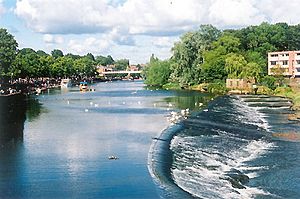
In 2007, Chester City Council announced a big plan. It aimed to make Chester a "must-see European destination." This plan, called Chester Renaissance, cost £1.3 billion.
A major project was the Northgate Development. It started in 2007. The goal was to create a new area with shops, homes, a performing arts centre, and a library. This project was paused in 2008 due to economic problems. However, other projects continued, like a new health centre and council headquarters. A new bus station opened in 2017. The Northgate Project is now being led by the council. It will include a new market hall, cinema, and car park. It is expected to be finished in 2022.
Getting Around Chester
Roads
Chester is a central point for major roads. The M53 motorway goes towards Liverpool. The M56 motorway leads to Manchester. The A55 road goes along the North Wales coast. The A483 connects Chester to Wrexham and Swansea in Wales.
Buses
Bus services in Chester are run by different companies. They connect the city to places like Liverpool, Rhyl, and Northwich. A new bus station opened in 2017. Chester also has four special park and ride sites. These are located on major roads around the city.
Trains
Chester railway station is served by several train companies. You can catch trains to London Euston, Liverpool, Manchester, and places in North Wales like Holyhead.
Train History
Chester used to have two railway stations. Chester General is still in use today (now just called 'Chester'). But Chester Northgate closed in 1969. It was demolished in the 1970s. The site is now a leisure centre.
Chester General station opened in 1848. It was designed with an Italian style. It now has seven platforms but once had fourteen. In 1972, the station's original roof was damaged in a train accident. In 2007, the station was renovated to improve access and parking.
In 1847, the Dee bridge disaster happened. A bridge span collapsed as a train crossed the River Dee. Five people died. The bridge was designed by the famous engineer Robert Stephenson. An investigation found that the cast iron beams used were not strong enough. This led to many similar bridges being changed or removed across the country.
Cycling
Chester has special cycling routes around the city. They are marked with different colours. In 2008, Chester was named a "cycling demonstration town." This meant it received money to improve cycling facilities. Many plans were made, but not all of them happened.
Canals
The Chester Canal was built with locks that led down to the River Dee. This allowed canal boats to enter the river and load goods onto larger ships. The port at Crane Wharf was important for trade in the North West.
The original Chester Canal opened in 1774. It ran from the River Dee to Nantwich. In 1805, the Wirral section of the Ellesmere Canal opened. This connected to the Chester Canal. Later, these canals became part of the Shropshire Union Canal network. This canal still runs under the northern part of Chester's city walls and is used today.
From the late 1700s to the 1950s, narrowboats carried goods like coal, slate, and lead on the canal. Grain was stored in buildings by the canal. Salt for food came from Northwich.
Trams
Chester had a tram service from the late 1800s to the early 1900s. It ran from Saltney to Chester General station. These trams had a very narrow track width. This was because a law said they had to be as small as possible.
The tramway started in 1871 with horse-drawn trams. The council took it over in 1903 and made it electric. The tramway closed in 1930. Today, only small parts of the track remain buried under the roads. One old electric tram from 1903 is being restored.
Sports in Chester
Football

Chester was home to Chester City F.C.. They were founded in 1885. They played at their Sealand Road stadium until 1990. Then they moved to the new Deva Stadium in 1992. This stadium is unique because it sits right on the border between England and Wales. The club stopped playing in 2010 after 125 years.
Famous players who played for Chester City include Ian Rush, Lee Dixon, and Roberto Martínez.
After Chester City closed, a new team called Chester FC was formed. They play at the same stadium. They have been promoted several times and now play in the National League Premier Division.
Other Sports
Chester has a professional basketball team called Cheshire Phoenix. They play in the top league in the country. There is also a wheelchair basketball team, Celtic Warriors.
Chester Rugby Club plays rugby union. They have won the Cheshire Cup many times.
The River Dee is home to several rowing clubs. The city's annual rowing regatta is very old, possibly dating back to 1733. The Chester Raft Race is held every July on the river to raise money for charity.
Chester Racecourse hosts horse races from spring to autumn. These races attract many visitors.
Chester also has a successful hockey club and a handball team. There is an American football team called the Chester Romans. You can find golf courses near the city, including a public course.
The Northgate Arena is Chester's main leisure centre. The Victorian City Baths are in the city centre. In December 2011, the first Chester Santa Dash took place. It's a fun running event where people dress as Santa to raise money for charity.
Twin Towns
Chester is twinned with:
Famous People from Chester
- Waheed Arian (born 1983), a doctor born in Afghanistan.
- Sir Adrian Boult (1889–1983), a famous musical conductor.
- Randolph Caldecott (1846–86), an artist and book illustrator.
- Group Captain Leonard Cheshire (1917–1992), a World War II pilot and founder of a charity.
- Daniel Craig (born 1968), a well-known actor.
- John Douglas (1830–1911), an architect who designed many buildings in Chester.
- Conor Kostick (born 1964), a writer and historian.
- Michael Owen (born 1979), a former English football international.
- L. T. C. Rolt (1910–74), an engineering historian.
- Howard Skempton (born 1947), a composer.
- Beth Tweddle (born 1985), a World champion gymnast.
- Martin Tyler (born 1945), a famous football commentator.
- Ricky Walden (born 1982), a professional snooker player.
See also
 In Spanish: Chester para niños
In Spanish: Chester para niños








